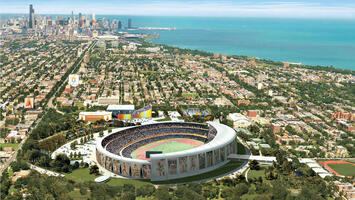
Time to answer that question: what would a 2016 Olympics meant to Chicago? After looking at the examples of the last two American Olympics, in Los Angeles in 1984 and Atlanta in 1996, I’ve come to some conclusions on how it could have played out in the Windy City. Here’s what I think we would’ve seen in the subsequent eight years, and the possible trajectory of the city going forward.
The Olympics would’ve accelerated the revitalization of Chicago’s south lakefront – yes, gentrification. One of Chicago’s main thrusts for pursuing the Olympics was to establish a revitalization foundation for the south lakefront, and the broader South Side of the city. It’s just my hunch, but I believe former mayor Richard M. Daley viewed the Olympics as a legacy project that would’ve demonstrated his commitment to the revitalization of the entire city, not just parts of it. If successful, the 2016 Games would’ve opened eyes to Chicago’s south lakefront in the same way that the Chicago Cubs, Wrigley Field and Superstation WGN cable broadcasting brought attention to the north lakefront in the 1980s and ‘90s.
I say “accelerate” because the south lakefront revitalization has been in the works for some time already. I noted in a Crain's Chicago Business article I co-authored with Ed Zotti and Mike Rothschild in 2021 that revitalization was happening, but at a slower pace than what happened up north:
“The 1997 film, "Love Jones," set in an undefined neighborhood on the South Side of Chicago, has long been a cult favorite among Black people. It explores life and love among Black professionals, artists and intellectuals—a group rarely seen in movies or on television. A lot of Black professionals yearn for the kind of neighborhood and lifestyle shown in the film.
Given the chance, many Black people would prefer to live in communities where they were well represented, either as the majority or a significant minority. It would mean their culture, perspective and lifestyle were validated.
The 2020 census gives us reason to think such a neighborhood—a diverse but predominantly Black community of middle-class professionals—is now emerging on Chicago’s south lakefront. We believe this is a historic opportunity for both Black people and Chicago and propose a way to make the most of it at modest cost.
In a cluster of nine south lakefront communities extending from the Near South Side to South Shore, the population is growing, the percentage of college graduates is increasing, home values are rising and crime is falling.
The south lakefront (and the lakefront generally) is gaining people, while interior neighborhoods are losing them.”
Data we collected for the article found that Black college-educated professionals are becoming a major factor on the south lakefront. Black college graduates in Chicago have increased by 24,000, or 24%, between 2010 and 2020 – this during a time when the non-college-grad Black population age 25+ dropped by 48,000. Black college grads live throughout the city, but significant concentrations can be found along the south lakefront, where in some areas they account for more than half of college grads.
Read the rest of this piece at The Corner Side Yard.
Pete Saunders is a writer and researcher whose work focuses on urbanism and public policy. Pete has been the editor/publisher of the Corner Side Yard, an urbanist blog, since 2012. Pete is also an urban affairs contributor to Forbes Magazine's online platform. Pete's writings have been published widely in traditional and internet media outlets, including the feature article in the December 2018 issue of Planning Magazine. Pete has more than twenty years' experience in planning, economic development, and community development, with stops in the public, private and non-profit sectors. He lives in Chicago.
Photo: Rendering of the 80,000-seat temporary Olympic Stadium that would’ve hosted the 2016 Olympic Games, if Chicago had beaten out Rio de Janeiro. It would’ve been located in Washington Park, on the city’s South Side. Source: chicagotribune.com












